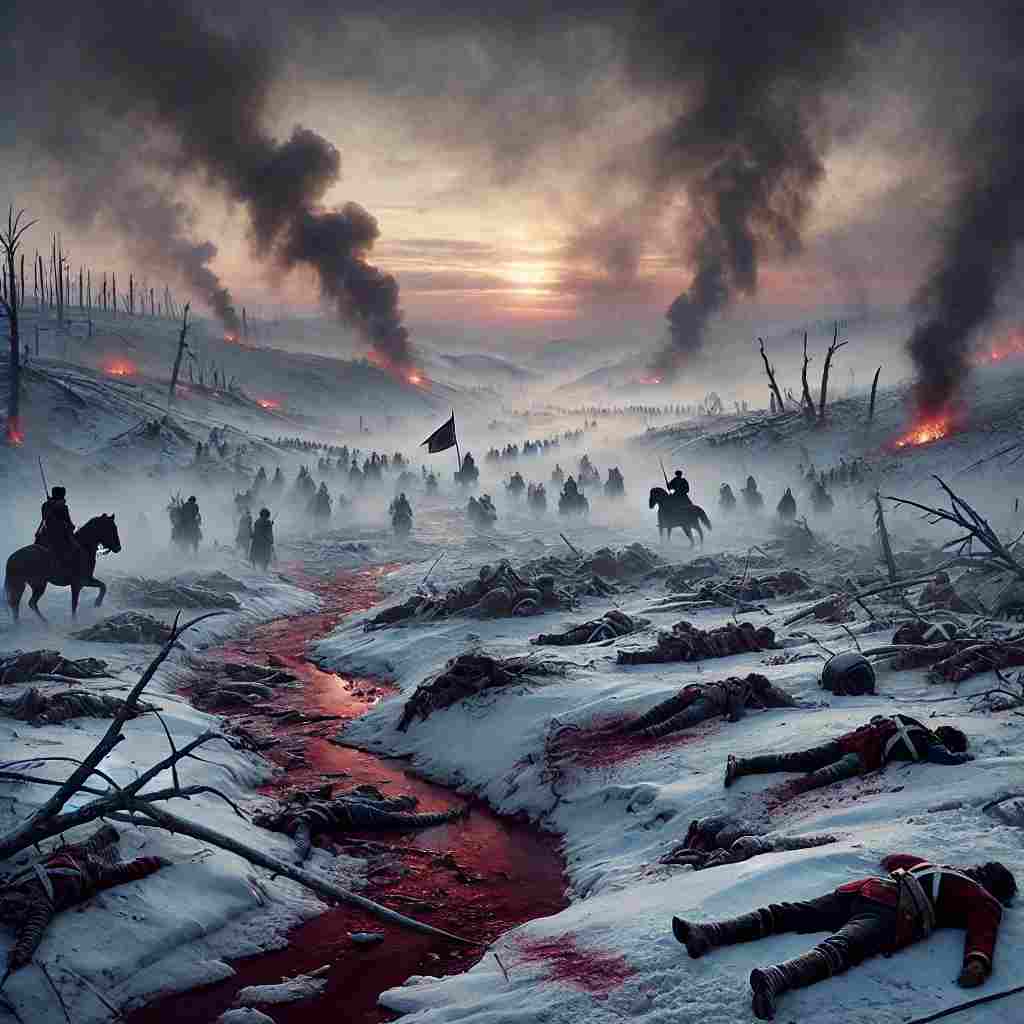Hohenlinden
Thomas Campbell
1777 to 1844

Want to track your favorites? Reopen or create a unique username. No personal details are required!
On Linden, when the sun was low,
All bloodless lay th' untrodden snow;
And dark as winter was the flow
Of Iser, rolling rapidly.
But Linden saw another sight,
When the drum beat, at dead of night,
Commanding fires of death to light
The darkness of her scenery.
By torch and trumpet fast array'd,
Each horseman drew his battle blade,
And furious every charger neigh'd,
To join the dreadful revelry.
Then shook the hills with thunder riv'n,
Then rush'd the steed to battle driv'n,
And louder than the bolts of heaven,
Far flash'd the red artillery.
But redder yet that light shall glow,
On Linden's hills of stained snow,
And bloodier yet the torrent flow
Of Iser, rolling rapidly.
'Tis morn, but scarce yon level sun
Can pierce the war-clouds, rolling dun,
Where furious Frank, and fiery Hun,
Shout in their sulph'rous canopy.
The combat deepens. On, ye brave,
Who rush to glory, or the grave!
Wave, Munich, all thy banners wave!
And charge with all thy chivalry!
Few, few, shall part where many meet!
The snow shall be their winding sheet,
And every turf beneath their feet,
Shall be a soldier's sepulchre.
Thomas Campbell's Hohenlinden
Introduction
Thomas Campbell's "Hohenlinden" stands as one of the most vivid and haunting battle poems in the English literary canon, chronicling the devastating clash between French and Austrian forces at the Battle of Hohenlinden in 1800. Through masterful manipulation of meter, imagery, and temporal progression, Campbell transforms a historical military engagement into a meditation on the terrible beauty of warfare and the ultimate futility of martial glory.
Historical Context and Poetic Form
The poem's setting draws from the December 3, 1800 battle between French revolutionary forces under Moreau and the Austrian army near the village of Hohenlinden (rendered as "Linden" in the poem) in Bavaria. Campbell employs a distinctive quatrain structure with trimeter lines and an AAAT rhyme scheme, where the fourth line of each stanza introduces a subtle variation. This formal choice creates a martial rhythm that mirrors both the drumbeats of war and the relentless forward momentum of the battle itself.
Temporal and Natural Imagery
Campbell structures the poem as a triptych of time: peaceful evening, violent night, and blood-stained dawn. The opening stanza establishes a deceptively peaceful scene with "bloodless" snow and the dark waters of the Iser River "rolling rapidly." This last phrase, repeated later with devastating effect, serves as both a formal anchor and a metaphor for the inexorable flow of violence and time.
The transition from peace to war is marked by the phrase "But Linden saw another sight," introducing personification that transforms the landscape into a witness to human brutality. The progression from natural to martial imagery is masterful: the "sun was low" becomes "fires of death," while the pristine snow will soon be "stained" with blood.
Military Spectacle and Sonic Landscapes
Campbell's genius for martial description manifests in his creation of a complete sensory experience. The poem's middle section builds through sound ("drum beat," "trumpet," "thunder riv'n") and sight ("flash'd the red artillery") to create a phantasmagoric spectacle of warfare. The repetition of "Then" in successive lines accelerates the tempo, matching the mounting intensity of the battle.
The sonic landscape is particularly noteworthy for its crescendo effect: from the initial drums, through the "furious" neighing of chargers, to the thunder of artillery, Campbell constructs an aural architecture of battle that builds to a devastating climax. This progression demonstrates his technical mastery in matching sound to sense.
Symbolism and Color Imagery
The poem's color symbolism deserves special attention. The progression from "bloodless" white snow through the "red artillery" to the final "bloodier yet" creates a chromatic narrative of increasing violence. The river Iser serves as a symbolic thread throughout the poem, its "dark" flow eventually becoming a "torrent" that mirrors the increasing chaos and bloodshed of the battle.
Campbell's use of light imagery is equally sophisticated, moving from natural light (the low sun) through artificial illumination (torches and artillery fire) to the grim dawn that can barely "pierce the war-clouds." This progression suggests both literal and metaphorical darkness descending upon humanity during warfare.
Voice and Perspective
The poem's narrative voice undergoes a fascinating transformation, beginning with objective description, moving through increasingly dramatic imagery, and culminating in direct address: "On, ye brave, / Who rush to glory, or the grave!" This shift in perspective implicates the reader in the martial spectacle while simultaneously forcing a confrontation with its human cost.
The Fatal Conclusion
Campbell's final stanza represents a masterpiece of understated tragedy. The triple repetition of "Few, few" and the transformation of natural elements (snow, turf) into funeral objects (winding sheet, sepulchre) creates a devastating critique of warfare's toll. The poem's closing movement returns to the natural world, but now irrevocably altered by human violence.
Conclusion
"Hohenlinden" achieves its power through Campbell's remarkable ability to combine technical mastery with emotional resonance. The poem's formal precision never comes at the expense of its humanitarian message, while its anti-war sentiment emerges naturally from description rather than explicit moralizing. Through careful manipulation of imagery, sound, and perspective, Campbell creates a work that transcends its historical moment to speak to the universal tragedy of warfare.
The poem's enduring relevance lies in its ability to capture both the seductive power of martial glory and its ultimate hollowness. In an age of increasingly mechanized warfare, Campbell's vision of battle's transformation of natural beauty into mass grave remains devastatingly pertinent. The rolling waters of the Iser continue to speak to us of warfare's persistent ability to transform the pastoral into the catastrophic, the natural into the nightmarishly unnatural.
This text was generated by AI and is for reference only. Learn more

